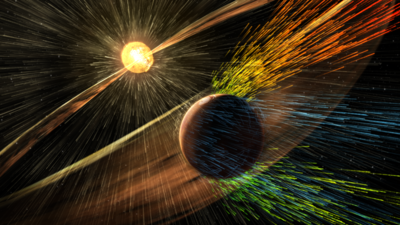- News
- Science News
- Nasa scientists gear up for solar storms at Mars
Nasa scientists gear up for solar storms at Mars

Image credits: Nasa/GSFC
NEW DELHI: Nasa's Mars missions are set to explore the impact of solar flares and other solar activities on the Red Planet during this year's solar maximum, a peak period of solar activity that occurs approximately every 11 years. Scientists are eager to learn how these intense solar events could affect both robotic missions and future human astronauts on Mars.
Unlike Earth, which is largely protected from solar radiation by its magnetic field, Mars has lost its global magnetic field, leaving it more exposed to harmful solar particles. This vulnerability makes it crucial for space agencies to understand and plan for the potential radiation risks to humans on Mars.
Shannon Curry, principal investigator for Nasa's MAVEN (Mars Atmosphere and Volatile EvolutioN) orbiter, expressed a keen interest in the phenomena: “For humans and assets on the Martian surface, we don’t have a solid handle on what the effect is from radiation during solar activity,” she said. “I’d actually love to see the ‘big one’ at Mars this year — a large event that we can study to understand solar radiation better before astronauts go to Mars.”
MAVEN, which operates from orbit around Mars, alongside the Curiosity rover, which roams its surface, are equipped to study the various aspects of solar radiation. Curiosity’s Radiation Assessment Detector (RAD) has been crucial in understanding how radiation impacts the Martian surface, potentially affecting the preservation of signs of ancient microbial life and informing the necessary protection measures for astronauts.
This research is not only vital for future manned missions but also enhances our understanding of Mars’ environmental changes. Nasa’s study of solar maximum could provide insights into why Mars transformed from a once warm, wet environment similar to early Earth into the arid desert it is today.
Moreover, the timing of this solar maximum coincides with Mars’ dustiest season, offering a unique opportunity to study concurrent dust and solar storms and their effects on the Martian atmosphere, including potential water vapor loss into space.
Nasa’s Goddard Space Flight Center manages the MAVEN mission, with Lockheed Martin responsible for the spacecraft and mission operations. The Curiosity rover, managed by Nasa’s Jet Propulsion Laboratory, continues to provide valuable data that aids in preparing for human exploration of Mars.
Unlike Earth, which is largely protected from solar radiation by its magnetic field, Mars has lost its global magnetic field, leaving it more exposed to harmful solar particles. This vulnerability makes it crucial for space agencies to understand and plan for the potential radiation risks to humans on Mars.
Shannon Curry, principal investigator for Nasa's MAVEN (Mars Atmosphere and Volatile EvolutioN) orbiter, expressed a keen interest in the phenomena: “For humans and assets on the Martian surface, we don’t have a solid handle on what the effect is from radiation during solar activity,” she said. “I’d actually love to see the ‘big one’ at Mars this year — a large event that we can study to understand solar radiation better before astronauts go to Mars.”
MAVEN, which operates from orbit around Mars, alongside the Curiosity rover, which roams its surface, are equipped to study the various aspects of solar radiation. Curiosity’s Radiation Assessment Detector (RAD) has been crucial in understanding how radiation impacts the Martian surface, potentially affecting the preservation of signs of ancient microbial life and informing the necessary protection measures for astronauts.
The interaction between Mars' thin atmosphere and solar radiation changes the intensity of the particles by the time they reach the surface. “You can have a million particles with low energy or 10 particles with extremely high energy,” explained Don Hassler, RAD’s principal investigator. “While MAVEN’s instruments are more sensitive to lower-energy ones, RAD is the only instrument capable of seeing the high-energy ones that make it through the atmosphere to the surface, where astronauts would be.”
This research is not only vital for future manned missions but also enhances our understanding of Mars’ environmental changes. Nasa’s study of solar maximum could provide insights into why Mars transformed from a once warm, wet environment similar to early Earth into the arid desert it is today.
Moreover, the timing of this solar maximum coincides with Mars’ dustiest season, offering a unique opportunity to study concurrent dust and solar storms and their effects on the Martian atmosphere, including potential water vapor loss into space.
Nasa’s Goddard Space Flight Center manages the MAVEN mission, with Lockheed Martin responsible for the spacecraft and mission operations. The Curiosity rover, managed by Nasa’s Jet Propulsion Laboratory, continues to provide valuable data that aids in preparing for human exploration of Mars.
End of Article
FOLLOW US ON SOCIAL MEDIA

